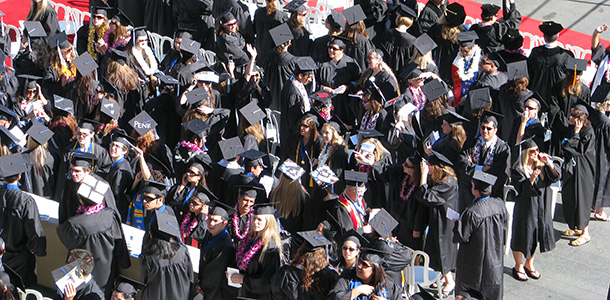
Cal State San Marcos graduation (Photo Credit: Rennett Stowe/Flickr)
If California is going to adopt public policies that can lift more people into the middle class, education will be part of the prescription. California State University Chancellor Timothy P. White leads a system of 23 campuses and a global community of 479,000 students, 50,000 faculty and staff and more than 3.3 million alumni.
On a recent episode of the factual-comedy TV series, Adam Ruins Everything, the host’s co-star and foil – a young prospective college student – suggested that a college degree wasn’t necessary to be successful in today’s economy.
The host, Adam, used numerous facts, figures and studies (all with citations, as any university professor would require) to prove wrong his young co-star’s argument devaluing a college degree.
In the process, Adam also made the case for why public higher education institutions in particular – institutions like the California State University – are so vital to ensuring the current and future socioeconomic success of our students, the state and nation.
Of course, we in higher education, business and public policy have anecdotal evidence of the generational shifts in the economy that will fundamentally change how we teach, work and live in the years and decades to come. Employers are increasingly searching for candidates who are specialized, highly trained and well educated and capable of ongoing learning to adapt quickly and nimbly to change throughout life.
Data supports this, too. College graduates make more than high school graduates at every point in their career. According to the nonpartisan Bureau of Labor Statistics, less than one percent of the 6 million jobs created in this country since 2009 have gone to those with a high school diploma or less.
In American manufacturing – where well-paying careers in the past could be forged with only a high school diploma – more jobs are now posted in software development than the production line.
We also know that California is facing a shortage of more than one million college graduates by 2030, with many of those open positions in the highly-technical, advanced and specialized fields like computer science, software development and engineering.
These massive economic and societal shifts cannot be overstated.
What worries me today is many people underestimate the seriousness of this growing degree drought. The lack of a college-educated workforce in California will stymie innovation, stagnate wage growth and hurt communities across the state, including those historically underserved and underrepresented in our colleges and economy.
That’s why the CSU and its sibling institutions, the University of California and the California Community Colleges (CCC), are working together to ensure that every qualified student – regardless of background or circumstance – has the opportunity for a rigorous, high-quality education built to meet the needs of tomorrow’s economy.
The CCC system has committed to increasing the number of transfer students to the CSU and UC by 35 percent. An inspiring goal, and certainly one that I appreciate and applaud.
The CSU has committed itself to increasing graduation rates, decreasing time to degree (which lowers per-degree costs for students and taxpayers alike), and eliminating achievement and equity gaps among all students.
Seventeen CSU campuses partner with their local municipalities, K-12 schools and community college districts to build and sustain College Promise programs, which help countless students successfully navigate their way to college and a degree.
We’ve also gone all-in on the Associate Degree for Transfer (ADT) program, sometimes referred to as a Degree with a Guarantee, which ensures admission to a CSU campus for community college graduates who successfully navigate the program. Data indicate that students who earn an ADT and subsequently transfer to the CSU graduate with their bachelor’s degree at much higher rates – and in less time and cost – than their peers.
Lastly, the CSU – as part of our commitment to eliminating achievement and equity gaps – is collaborating with faculty, staff, students, administrators and national experts to revamp the assessment and placement of first-year freshmen, the Early Start Program and developmental (previously referred to as remedial) education.
As a result, every CSU student will be on a path to earning a degree on their first day on campus.
Together, these initiatives and programs – along with many others – are designed to ensure that we are fulfilling the founding vision and promise of California’s higher education institutions.
The California Master Plan for Higher Education – our founding vision, now over a half-century old – revolutionized college and university education, moving it from an elites-only enterprise to an institution expressly accessible to all Californians, regardless of background or socioeconomic circumstance.
And personally, as a beneficiary having attended a California community college, the CSU and UC as a student in the 1960s and 1970s, I know firsthand the vital individual and public value this visionary and essential plan still bestows.
As the national model and global leader in public higher education, California has reaped the benefits of the investment and foresight since 1960.
The state's economy is the sixth largest in the world. We are the global center for culture, technology and discovery – as our state’s global trade, manufacturing and agricultural output combines with contributions from the iconic Hollywood and Silicon Valley.
Make no mistake. California’s success over the past fifty years is due to its highly educated, motivated and innovative workforce – made up largely of alumni from the CSU, UC and CCC.
Indeed, for California to remain an innovative powerhouse, it is dependent on a college educated workforce.
 As it turns out, Adam Ruins Everything is made in California. Knowing our deep alumni network in the entertainment industry, I would imagine that a good number of the people who make the show either work with or are themselves graduates of the CSU.
As it turns out, Adam Ruins Everything is made in California. Knowing our deep alumni network in the entertainment industry, I would imagine that a good number of the people who make the show either work with or are themselves graduates of the CSU.
So thanks, Adam, for the shout-out.
And yes, you’re right. College is absolutely critical, and the best option for an affordable, high-quality education is a public college and university like the California State University.

